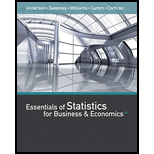
Concept explainers
Identify the mutual fund that performs better.
Answer to Problem 20E
The Mutual Fund T performs better.
Explanation of Solution
Calculation:
The investigator has invested $10,000 at the beginning of 2004 in mutual fund S and $5,000 in Mutual Fund T. The value of each investment at the end of each subsequent year is given.
The geometric
The general formula to obtain growth factor for a year is given below:
Denote the values of growth factors of Mutual Fund S for year 2004 to year 2011 as
The growth factor of Mutual Fund S for year 2004 is obtained as given below:
Denote the values of growth factors of Mutual Fund T for year 2004 to year 2011 as
The growth factor of Mutual Fund T for year 2004 is obtained as given below:
Similarly, growth factors of Mutual Fund S and Mutual Fund T for the remaining years are obtained in the table given below:
| Year | Mutual Fund S | Mutual Fund T | ||
| End of Year Value | Growth Factor | End of Year Value | Growth Factor | |
| 2004 | $11,000 | 1.100 | $5,600 | 1.120 |
| 2005 | $12,000 | 1.091 | $6,300 | 1.125 |
| 2006 | $13,000 | 1.083 | $6,900 | 1.095 |
| 2007 | $14,000 | 1.077 | $7,600 | 1.101 |
| 2008 | $15,000 | 1.071 | $8,500 | 1.118 |
| 2009 | $16,000 | 1.067 | $9,200 | 1.082 |
| 2010 | $17,000 | 1.063 | $9,900 | 1.076 |
| 2011 | $18,000 | 1.059 | $10,600 | 1.071 |
The general formula to obtain geometric mean is given below:
Mutual Fund S:
The mean growth factor of Mutual Fund S over the year 2004 to year 2011 is obtained below:
Thus, the mean growth factor of Mutual Fund S over the years 2004 to 2011 is 1.07624.
The mean annual return of Mutual Fund S over the years 2004 to 2011 is obtained below:
Thus, the mean annual return of Mutual Fund S over the years 2004 to 2011 is 7.624%.
For the Mutual Fund T:
The mean growth factor of Mutual Fund T over the years 2004 to 2011 is obtained below:
Thus, the mean growth factor of Mutual Fund T over the years 2004 to 2011 is 1.09848.
The mean annual return of Mutual Fund T over the years 2004 to 2011 is obtained below:
Thus, the mean annual return of Mutual Fund T over the years 2004 to 2011 is 9.848%.
The mean annual return or mean annual growth rate of Mutual Fund T is 9.848% and mean annual return or mean annual growth rate of Mutual Fund S is 7.624%.
Since
Hence, it can be concluded that Mutual Fund T performs better than Mutual Fund S.
Want to see more full solutions like this?
Chapter 3 Solutions
Essentials of Statistics for Business and Economics (with XLSTAT Printed Access Card)
- Let X be a random variable with support SX = {−3, 0.5, 3, −2.5, 3.5}. Part ofits probability mass function (PMF) is given bypX(−3) = 0.15, pX(−2.5) = 0.3, pX(3) = 0.2, pX(3.5) = 0.15.(a) Find pX(0.5).(b) Find the cumulative distribution function (CDF), FX(x), of X.1(c) Sketch the graph of FX(x).arrow_forwardA well-known company predominantly makes flat pack furniture for students. Variability with the automated machinery means the wood components are cut with a standard deviation in length of 0.45 mm. After they are cut the components are measured. If their length is more than 1.2 mm from the required length, the components are rejected. a) Calculate the percentage of components that get rejected. b) In a manufacturing run of 1000 units, how many are expected to be rejected? c) The company wishes to install more accurate equipment in order to reduce the rejection rate by one-half, using the same ±1.2mm rejection criterion. Calculate the maximum acceptable standard deviation of the new process.arrow_forward5. Let X and Y be independent random variables and let the superscripts denote symmetrization (recall Sect. 3.6). Show that (X + Y) X+ys.arrow_forward
- 8. Suppose that the moments of the random variable X are constant, that is, suppose that EX" =c for all n ≥ 1, for some constant c. Find the distribution of X.arrow_forward9. The concentration function of a random variable X is defined as Qx(h) = sup P(x ≤ X ≤x+h), h>0. Show that, if X and Y are independent random variables, then Qx+y (h) min{Qx(h). Qr (h)).arrow_forward10. Prove that, if (t)=1+0(12) as asf->> O is a characteristic function, then p = 1.arrow_forward
- 9. The concentration function of a random variable X is defined as Qx(h) sup P(x ≤x≤x+h), h>0. (b) Is it true that Qx(ah) =aQx (h)?arrow_forward3. Let X1, X2,..., X, be independent, Exp(1)-distributed random variables, and set V₁₁ = max Xk and W₁ = X₁+x+x+ Isk≤narrow_forward7. Consider the function (t)=(1+|t|)e, ER. (a) Prove that is a characteristic function. (b) Prove that the corresponding distribution is absolutely continuous. (c) Prove, departing from itself, that the distribution has finite mean and variance. (d) Prove, without computation, that the mean equals 0. (e) Compute the density.arrow_forward
- 1. Show, by using characteristic, or moment generating functions, that if fx(x) = ½ex, -∞0 < x < ∞, then XY₁ - Y2, where Y₁ and Y2 are independent, exponentially distributed random variables.arrow_forward1. Show, by using characteristic, or moment generating functions, that if 1 fx(x): x) = ½exarrow_forward1990) 02-02 50% mesob berceus +7 What's the probability of getting more than 1 head on 10 flips of a fair coin?arrow_forward
 Intermediate AlgebraAlgebraISBN:9781285195728Author:Jerome E. Kaufmann, Karen L. SchwittersPublisher:Cengage Learning
Intermediate AlgebraAlgebraISBN:9781285195728Author:Jerome E. Kaufmann, Karen L. SchwittersPublisher:Cengage Learning Algebra for College StudentsAlgebraISBN:9781285195780Author:Jerome E. Kaufmann, Karen L. SchwittersPublisher:Cengage Learning
Algebra for College StudentsAlgebraISBN:9781285195780Author:Jerome E. Kaufmann, Karen L. SchwittersPublisher:Cengage Learning Trigonometry (MindTap Course List)TrigonometryISBN:9781337278461Author:Ron LarsonPublisher:Cengage Learning
Trigonometry (MindTap Course List)TrigonometryISBN:9781337278461Author:Ron LarsonPublisher:Cengage Learning

 Holt Mcdougal Larson Pre-algebra: Student Edition...AlgebraISBN:9780547587776Author:HOLT MCDOUGALPublisher:HOLT MCDOUGAL
Holt Mcdougal Larson Pre-algebra: Student Edition...AlgebraISBN:9780547587776Author:HOLT MCDOUGALPublisher:HOLT MCDOUGAL





